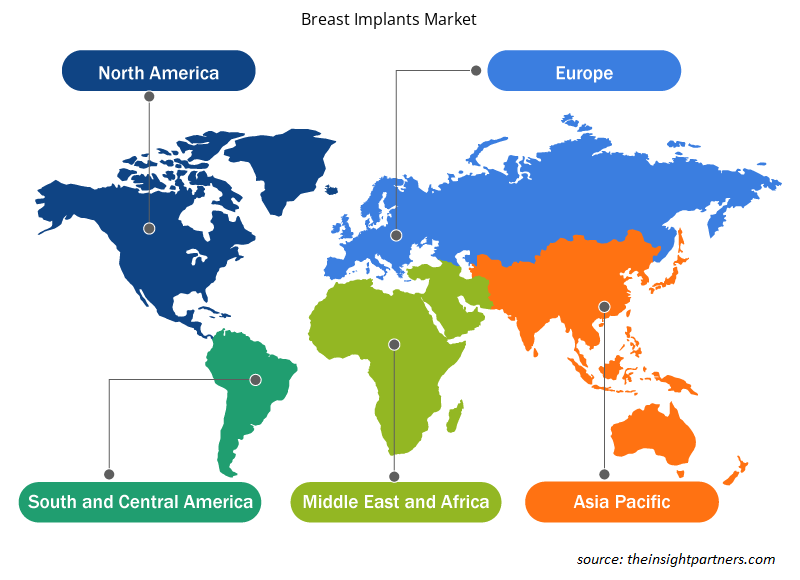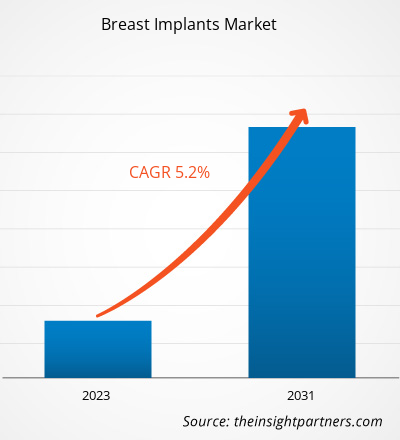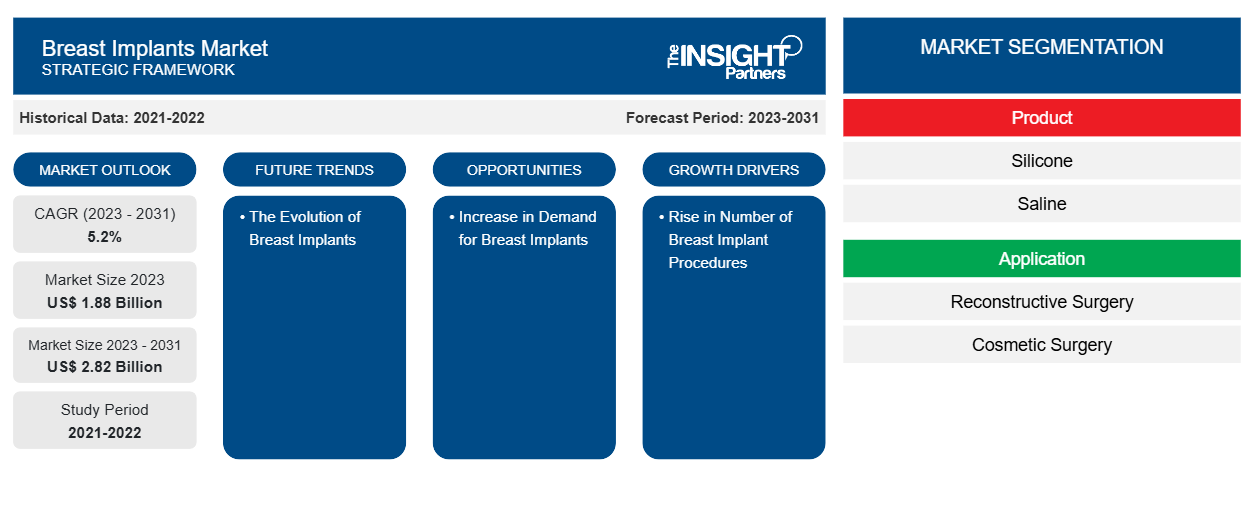Il mercato degli impianti mammari è stato valutato a 1,88 miliardi di dollari USA nel 2023 e si prevede che raggiungerà i 2,82 miliardi di dollari USA entro il 2031. Si prevede che il mercato registrerà un CAGR del 5,2% nel 2023-2031. L'evoluzione degli impianti mammari rimarrà probabilmente una tendenza di mercato.CAGR of 5.2% in 2023–2031. The evolution of breast implants will likely remain a market trend.
Analisi di mercato degli impianti mammari
Sul mercato degli impianti mammari sono disponibili vari prodotti e tecniche per migliorare le dimensioni o la forma del seno. Fattori come i nuovi sviluppi tecnologici, le tendenze cosmetiche, i problemi di sicurezza e gli adeguamenti legislativi hanno un impatto. Produttori, chirurghi, cliniche e agenzie di regolamentazione sono esempi di partecipanti al mercato. Le tendenze recenti includono maggiori precauzioni di sicurezza, un passaggio verso risultati dall'aspetto più naturale e un aumento del desiderio di alternative non invasive.
Panoramica del mercato degli impianti mammari
È una procedura estetica in cui vengono posizionati degli impianti sotto il seno per renderlo più grande. L'anatomia del seno, il tipo di corpo, lo spessore e l'elasticità della pelle e la quantità di tessuto mammario richiesto influenzano il tipo e le dimensioni degli impianti. Un aumento del seno può aumentare la sicurezza di una donna per alcune donne. Per alcune, è una componente necessaria della ricostruzione del seno a causa di diversi disturbi. Si prevede che il mercato crescerà a causa della crescente incidenza del cancro al seno, dell'approvazione di nuovi prodotti da parte della FDA, dell'aumento degli interventi di chirurgia estetica e di aumento del seno e di altri fattori.FDA's approval of new products, the rise in cosmetic and breast augmentation surgeries, and other factors.
Personalizza questo report in base alle tue esigenze
Riceverai la personalizzazione gratuita di qualsiasi report, comprese parti di questo report, o analisi a livello nazionale, pacchetto dati Excel, oltre a usufruire di grandi offerte e sconti per start-up e università
-
Scopri le principali tendenze di mercato in questo rapporto.Questo campione GRATUITO includerà analisi di dati che spaziano dalle tendenze di mercato alle stime e alle previsioni.
Driver e opportunità del mercato degli impianti mammari
Aumento del numero di procedure di impianto mammario per favorire il mercato
L'aumento del seno, a volte indicato come mastoplastica additiva, è un tipo di intervento chirurgico di ingrandimento del seno. Comporta l'inserimento di protesi mammarie sotto i muscoli o i tessuti del torace. Attualmente, una delle procedure di chirurgia estetica più comuni e alla moda in tutto il mondo è la chirurgia implantare mammaria. Le donne stanno diventando più consapevoli del proprio corpo a seguito della modernizzazione. Ciò aumenta il numero di procedure di protesi mammarie eseguite, il che alimenta l'espansione del mercato. Ad esempio, secondo l'International Society of Aesthetic Plastic Surgery, le procedure di aumento del seno continuano a essere la procedura chirurgica più popolare per le donne a livello globale, con 2,2 milioni eseguite nel 2022, un notevole aumento del 29% rispetto al 2021. Con oltre 4,4 milioni di procedure eseguite sul seno, un aumento del 25% rispetto all'anno precedente, tutte le procedure al seno mostrano una crescita notevole.mammoplasty, is a type of breast enlargement surgery. It entails putting breast implants beneath the muscles or tissue of the chest. Currently, one of the most common and fashionable cosmetic surgery procedures worldwide is breast implant surgery. Women are growing more aware of their bodies as a result of modernization. This raises the number of breast implant procedures performed, which fuels the market's expansion. For instance, according to the International Society of Aesthetic Plastic Surgery, breast augmentation procedures continue to be the most popular surgical procedure for women globally, with 2.2 million performed in 2022—a notable 29% increase from 2021. With over 4.4 million procedures performed on the breast, a 25% increase from the previous year, all breast procedures show notable growth.
Aumento della domanda di protesi mammarie: un’opportunità nel mercato delle protesi mammarie
La procedura di chirurgia plastica più popolare tra le donne in tutto il mondo è l'impianto mammario (BI). Il BI è in genere utilizzato nelle procedure oncoplastiche e cosmetiche. Secondo Medicine 2021, nel 2020 negli Stati Uniti sono state eseguite oltre 300.000 procedure che includevano interventi di aumento del seno e ricostruzione. Il 58,4% delle pazienti ha subito un aumento del seno; queste pazienti avevano principalmente un'età compresa tra i 30 e i 40 anni. Rispetto ai dati del 2000, si è registrato un aumento del 41% nel numero di interventi di aumento del seno e la domanda continua a crescere ogni anno. Pertanto, è probabile che un aumento della domanda di impianti mammari crei significative opportunità di mercato.oncoplastic and cosmetic procedures. According to Medicine 2021, over 300,000 procedures involving breast augmentation and reconstruction surgeries were performed in the US in 2020. 58.4% of patients had breast augmentations; these patients were primarily in their 30s to 40s. Compared to the data from 2000, there was a 41% increase in the number of breast augmentation surgeries, and the demand for them continues to rise yearly. Thus, an increase in demand for breast implants is likely to create significant market opportunities.
Analisi della segmentazione del rapporto di mercato degli impianti mammari
I segmenti chiave che contribuiscono alla derivazione dell'analisi del mercato degli impianti mammari sono il prodotto, l'applicazione e il tipo di superficie.
- In base al prodotto, il mercato delle protesi mammarie è diviso in silicone e soluzione salina. Il segmento in silicone ha detenuto una quota di mercato maggiore nel 2023.
- Per prodotto, il mercato è segmentato in chirurgia ricostruttiva, chirurgia estetica. Il segmento della chirurgia estetica ha detenuto la quota maggiore del mercato nel 2023.
- In base al tipo di superficie, il mercato si divide in liscia e strutturata.
Analisi della quota di mercato degli impianti mammari per area geografica
L'ambito geografico del rapporto sul mercato degli impianti mammari è suddiviso in cinque regioni: Nord America, Asia Pacifico, Europa, Medio Oriente e Africa e Sud America/Sud e Centro America.
Il Nord America ha dominato il mercato delle protesi mammarie. In Nord America, gli Stati Uniti sono il mercato più grande per le protesi mammarie nel 2023. L'esistenza di organizzazioni di regolamentazione come Health Canada e la crescente accettazione delle protesi mammarie nella regione sono i principali motori della crescita del mercato in Nord America. Il motore principale dell'espansione del mercato delle protesi mammarie dell'Unione Europea è l'esistenza di politiche di regolamentazione sindacali. Inoltre, alcuni paesi europei hanno costi inferiori per vari interventi chirurgici medici a seconda della procedura. L'accettazione delle protesi mammarie in questa regione è aiutata dalla crescente consapevolezza delle protesi mammarie tra gli europei. Il mercato delle protesi mammarie nell'Asia Pacifica si sta espandendo rapidamente a causa della crescente incidenza del cancro al seno. Durante il periodo di previsione, si prevede che il mercato delle protesi mammarie nell'Asia Pacifica crescerà in parte a causa del crescente reddito disponibile delle nazioni asiatiche. La crescita del mercato è anche attribuita alla crescente consapevolezza di migliorare il proprio aspetto fisico.U.S. is the largest market for breast implants in 2023. The existence of regulatory organizations like Health Canada and the growing acceptance of breast implants in the region are the main drivers of market growth in North America. The primary driver of the European Union's breast implant market expansion is the existence of union regulatory policies. Furthermore, some European countries have lower costs for various medical surgeries depending on the procedure. The acceptance of breast implants in this region is being aided by the growing awareness of breast implants among Europeans. The market for breast implants in Asia Pacific is expanding quickly as a result of the rising incidence of breast cancer. Throughout the forecast period, the Asia Pacific market for breast implants is expected to grow due in part to the rising disposable income of Asian nations. The growing market is also attributed to rising awareness of improving one's physical appearance.
Approfondimenti regionali sul mercato degli impianti mammari
Le tendenze regionali e i fattori che influenzano il mercato delle protesi mammarie durante il periodo di previsione sono stati ampiamente spiegati dagli analisti di Insight Partners. Questa sezione discute anche i segmenti e la geografia del mercato delle protesi mammarie in Nord America, Europa, Asia Pacifico, Medio Oriente e Africa e Sud e Centro America.

- Ottieni i dati specifici regionali per il mercato degli impianti mammari
Ambito del rapporto sul mercato degli impianti mammari
| Attributo del report | Dettagli |
|---|---|
| Dimensioni del mercato nel 2023 | 1,88 miliardi di dollari USA |
| Dimensioni del mercato entro il 2031 | 2,82 miliardi di dollari USA |
| CAGR globale (2023-2031) | 5,2% |
| Dati storici | 2021-2022 |
| Periodo di previsione | 2023-2031 |
| Segmenti coperti |
Per Prodotto
|
| Regioni e Paesi coperti |
America del Nord
|
| Leader di mercato e profili aziendali chiave |
|
Densità degli attori del mercato: comprendere il suo impatto sulle dinamiche aziendali
Il mercato delle protesi mammarie sta crescendo rapidamente, spinto dalla crescente domanda degli utenti finali dovuta a fattori quali l'evoluzione delle preferenze dei consumatori, i progressi tecnologici e una maggiore consapevolezza dei benefici del prodotto. Con l'aumento della domanda, le aziende stanno ampliando le loro offerte, innovando per soddisfare le esigenze dei consumatori e capitalizzando sulle tendenze emergenti, il che alimenta ulteriormente la crescita del mercato.
La densità degli operatori di mercato si riferisce alla distribuzione di aziende o società che operano in un particolare mercato o settore. Indica quanti concorrenti (operatori di mercato) sono presenti in un dato spazio di mercato in relazione alle sue dimensioni o al valore di mercato totale.
Le principali aziende che operano nel mercato degli impianti mammari sono:
- Allergan SpA
- Mentor Worldwide LLC (J&J)
- Estetica GC
- Sientra, Inc
- Salute e POLITECNICA
- Estetica GmbH
Disclaimer : le aziende elencate sopra non sono classificate secondo un ordine particolare.

- Ottieni una panoramica dei principali attori del mercato degli impianti mammari
Notizie e sviluppi recenti sul mercato degli impianti mammari
Il mercato degli impianti mammari viene valutato raccogliendo dati qualitativi e quantitativi post-ricerca primaria e secondaria, che includono importanti pubblicazioni aziendali, dati associativi e database. Di seguito è riportato un elenco degli sviluppi nel mercato degli impianti mammari e delle strategie:
- Establishment Labs Holdings Inc., un'azienda globale di tecnologia medica dedicata al miglioramento della salute e del benessere delle donne, principalmente nell'ambito dell'estetica e della ricostruzione del seno, ha annunciato oggi il lancio di Motiva Implants in Cina. (Fonte: Establishment Labs Holdings Inc. Nome dell'azienda, comunicato stampa, 2024)
- CollPlant Biotechnologies, un'azienda di medicina rigenerativa ed estetica che sviluppa tecnologie e prodotti innovativi basati sul suo collagene non derivato da animali per la rigenerazione dei tessuti e la produzione di organi, ha annunciato l'avvio di una sperimentazione preclinica per valutare protesi mammarie rigenerative di dimensioni commerciali, stampate in 3D. (Fonte: CollPlant Biotechnologies Company Name, Newsletter, 2024)
Copertura e risultati del rapporto sul mercato degli impianti mammari
Il rapporto "Dimensioni e previsioni del mercato degli impianti mammari (2021-2031)" fornisce un'analisi dettagliata del mercato che copre le seguenti aree:
- Dimensioni e previsioni del mercato a livello globale, regionale e nazionale per tutti i segmenti di mercato chiave coperti dall'ambito
- Dinamiche di mercato come fattori trainanti, vincoli e opportunità chiave
- Principali tendenze future
- Analisi dettagliata delle cinque forze PEST/Porter e SWOT
- Analisi di mercato globale e regionale che copre le principali tendenze di mercato, i principali attori, le normative e gli sviluppi recenti del mercato
- Analisi del panorama industriale e della concorrenza che copre la concentrazione del mercato, l'analisi della mappa di calore, i principali attori e gli sviluppi recenti
- Profili aziendali dettagliati
- Analisi storica (2 anni), anno base, previsione (7 anni) con CAGR
- Analisi PEST e SWOT
- Valore/volume delle dimensioni del mercato - Globale, Regionale, Nazionale
- Industria e panorama competitivo
- Set di dati Excel
Report recenti
Rapporti correlati
Testimonianze
Motivo dell'acquisto
- Processo decisionale informato
- Comprensione delle dinamiche di mercato
- Analisi competitiva
- Analisi dei clienti
- Previsioni di mercato
- Mitigazione del rischio
- Pianificazione strategica
- Giustificazione degli investimenti
- Identificazione dei mercati emergenti
- Miglioramento delle strategie di marketing
- Aumento dell'efficienza operativa
- Allineamento alle tendenze normative























 Ottieni un campione gratuito per - Mercato degli impianti mammari
Ottieni un campione gratuito per - Mercato degli impianti mammari